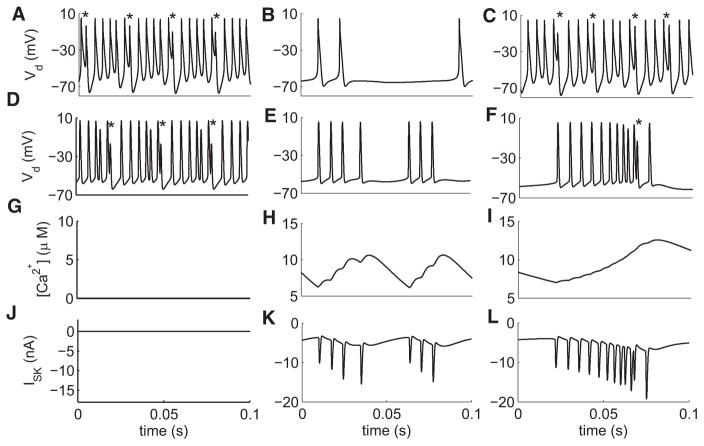FIG. 8.
Modeling the differences between bursting seen in vitro and bursting seen in vivo. A: simulation of a large multicompartmental model of an ELL pyramidal cell with partially blocked SK current (i.e., gSK = 2.06 μS) produces burst firing with dendritic failures (asterisk). B: increasing SK current (gSK = 7× 10−5 μS, fCa = 0.03/ms) counteracts the DAP and does not lead to dendritic failure in the dendritic membrane potential. C: increasing the calcium time constant (i.e., setting fCa = 0.0008/ms) in the model reproduces the effects of BAPTA. Dendritic failures are seen in the dendritic membrane potential (asterisks). D: simulation of the reduced 2-compartmental model without an NMDA current (i.e., gnmda = 0) produced burst firing that was qualitatively similar to that seen with the large model with dendritic failures (asterisk). E: addition of the NMDA current (gnmda = 20 mS/cm2, fCa = 0.03/ms) counteracts the DAP and does not lead to dendritic failure in the dendritic membrane potential. F: increasing the calcium time constant (i.e., setting fCa = 0.008/ms) in the model reproduces the effects of BAPTA. Dendritic failures are seen in the dendritic membrane potential (asterisk). G: Ca2+ concentration as a function of time in the reduced model with gnmda = 0. H: setting gnmda = 20 mS/cm2, fCa = 0.03/ms causes accumulation of calcium during repetitive firing. The calcium concentration decreases during periods of silence. Note that the cumulative increase in the current is mostly because of the depolarization throughout the burst (E) that is caused by the DAP growth and not because of the conductance that saturates well before 10 μM. I: setting fCa = 0.008/ms causes a slower accumulation of calcium during repetitive firing. J: SK current as a function of time for gnmda = 0. K: setting gnmda = 20 mS/cm2, fCa = 0.03/ms causes a rapid accumulation of calcium during repetitive firing that causes cumulative activation of the SK current, which leads to early burst termination. L: setting fCa = 0.008/ms causes a slower cumulative activation of the SK current, which is not enough to prevent burst termination by a dendritic failure.

